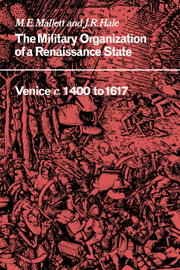Book contents
- Frontmatter
- Contents
- List of illustrations
- Acknowledgements
- References and abbreviations
- Map 1 The Terraferma in the fifteenth and sixteenth centuries
- Map 2 The empire da Mar
- PART I c. 1400 to 1508
- Introduction: the European context 1400–1525
- 1 The beginnings of Venetian expansion
- 2 The composition and role of the army in the fifteenth century
- 3 Military development and fighting potential
- 4 The organization and administration of the Venetian army
- 5 Control and policy making
- 6 Soldiers and the state
- 7 Venice and war
- PART II 1509–1617
- Conclusion: the European context 1525–1617
- Appendix Infantry wages in the sixteenth century
- Select bibliography
- Index
5 - Control and policy making
Published online by Cambridge University Press: 22 October 2009
- Frontmatter
- Contents
- List of illustrations
- Acknowledgements
- References and abbreviations
- Map 1 The Terraferma in the fifteenth and sixteenth centuries
- Map 2 The empire da Mar
- PART I c. 1400 to 1508
- Introduction: the European context 1400–1525
- 1 The beginnings of Venetian expansion
- 2 The composition and role of the army in the fifteenth century
- 3 Military development and fighting potential
- 4 The organization and administration of the Venetian army
- 5 Control and policy making
- 6 Soldiers and the state
- 7 Venice and war
- PART II 1509–1617
- Conclusion: the European context 1525–1617
- Appendix Infantry wages in the sixteenth century
- Select bibliography
- Index
Summary
The army created by Venice in the fifteenth century was a cumbersome and unreliable instrument the effectiveness of which depended very largely on how it was wielded. The organization already described was the means of control in peacetime, but in war dynamic and effective leadership in the field and swift and informed decision making in Venice were essential adjuncts to that organization. Above all, perhaps, what was essential for effective military action was the smooth passage of orders and advice from the councils in Venice to the commanders in the field so that policy could be translated into action. How far did Venice in the fifteenth century achieve these desirable goals?
Lorenzo Loredan in his tour of duty as proveditor-general in the late 1470s commented frequently on the necessity for firm leadership in military affairs. But in fact he never had to deal with a captain-general, as Colleoni had died quite recently and had not been replaced. Hence he was not directly confronted with that crucial dilemma inherent in all emerging standing armies of how to maintain control from the centre and yet at the same time entrust the precious weapon to a prestigious and often ambitious military commander. Venice, as a state committed to a practice of collective decision making, found it particularly difficult to accept that success in war depended to a large extent on the authority and determination of one man, the military commander. On the other hand, Venetian nobles as individuals were more than usually accustomed to the necessity for strong personal leadership in their maritime experience. Hence Venetian policy on this issue tended to fluctuate during the fifteenth century.
- Type
- Chapter
- Information
- The Military Organisation of a Renaissance StateVenice c.1400 to 1617, pp. 153 - 180Publisher: Cambridge University PressPrint publication year: 1984



